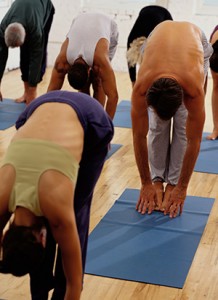by Mimi Solaire —

The goal of stretching is to reclaim your body’s unique capacity for flexibility. Put another way, stretching helps us feel comfortable inside our bodies so that we can enjoy the things we love to do.
Stretching not only relaxes the body but also has a calming effect on the mind and emotions. Some of the benefits of stretching include mental and physical relaxation; body awareness; reduction of muscular tension and soreness; production of chemicals that lubricate connective tissues and joints, helping reduce injury to joints, ligaments, muscles and tendons; and enhanced physical fitness.
You must understand three important things before incorporating a stretching routine into your fitness program.
1. Stretching should never be painful. Many people resist stretching because of previous experiences which resulted in soreness or even injury. To stretch safely and efficiently, go slowly and be gentle.
Imagine that the tight areas of your body are similar to an onion, with layer upon layer of tension. Try relaxing the outermost layer first by gently stretching that area just enough to feel a mild sensation or resistance. Direct your breath into that area until you feel a release as the muscle relaxes. Then go deeper into the stretch as if releasing another layer of tension. Be sure to hold the stretch long enough to experience the release — about 3 to 5 minutes.
2. Muscles can only do two things, relax or contract. They cannot stretch. The muscles you are feeling when stretching are not the muscles that are stretching; they are the muscles that are resisting. Often, we are not aware of our chronically tight muscles. In fact, we’ve become accustomed to them being that way. Most of the exercises and activities we choose for sport or fitness contract the muscles for strength. However, a chronically contracted muscle eventually becomes a weak muscle because it constricts the flow of blood, nutrients and energy which the muscle needs to function.
The sensation we call stretching is experienced when a contracted muscle releases. Deep relaxation allows the muscles to return to their natural relaxed state. A relaxed body sends messages to the mind and emotions that “all is well” for an overall sense of well-being.
3. Set realistic goals. Our capacity for stretching is largely determined by our genes, which determine the amount of collagen in our bodies. Women have more collagen than men and, therefore, are generally more flexible. However, the greater limiting factor is stress.
Stress produces the chemical cortisol, which contracts muscles and tissues. An excess of this chemical is primarily responsible for the feeling of uptightness. Stretching helps release this chemical from the body, aided by the mind’s intention to relax. The goal of stretching is to reclaim your body’s unique capacity for flexibility. Put another way, stretching helps us feel comfortable inside our bodies so that we can enjoy the things we love to do.
Mimi Solaire is a yoga instructor who conducts workshops and classes on relieving chronic pain, back pain and stress. yogadance@cox.net or www.mimisolaire.com.
Reprinted from AzNetNews, Volume 24, Number 3, June/July 2005.





January 23, 2014
Emotional Wellness and Well-being, Exercise, Self-improvement, Serenity, Yoga